Celestron NEXSTAR 4 GT Manual
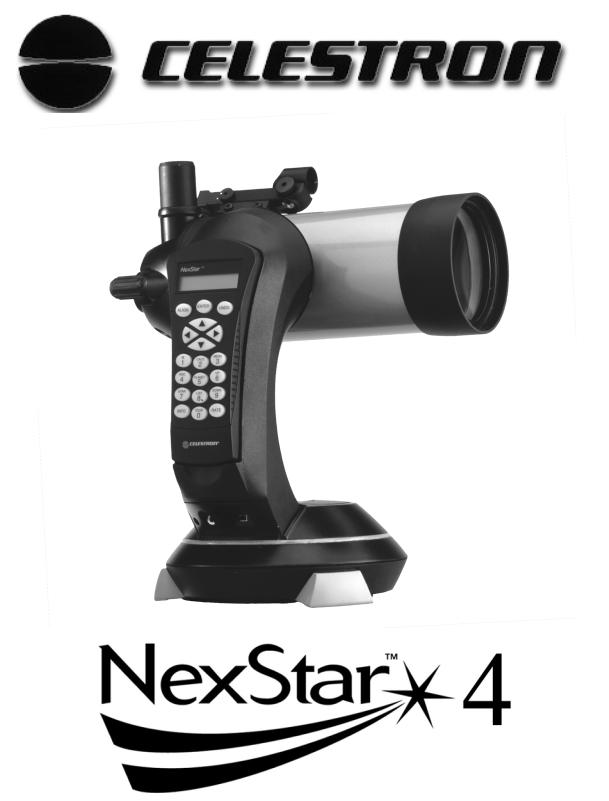
INSTRUCTION MANUAL
INTRODUCTION ........................................................................................................................................ |
4 |
WARNING ................................................................................................................................................... |
4 |
ASSEMBLY .................................................................................................................................................. |
8 |
ASSEMBLING THE NEXSTAR ....................................................................................................................... |
8 |
Powering the NexStar ............................................................................................................................ |
8 |
The Hand Control.................................................................................................................................. |
9 |
The Eyepiece.......................................................................................................................................... |
9 |
The Star Pointer Finderscope.............................................................................................................. |
10 |
HAND CONTROL ..................................................................................................................................... |
12 |
HAND CONTROL OPERATION .................................................................................................................... |
13 |
Alignment Procedure ........................................................................................................................... |
13 |
Auto-Align............................................................................................................................................ |
13 |
Two Star Alignment ............................................................................................................................. |
15 |
Quick-Align.......................................................................................................................................... |
15 |
NexStar Re-Alignment ......................................................................................................................... |
16 |
OBJECT CATALOG..................................................................................................................................... |
16 |
Selecting an Object .............................................................................................................................. |
16 |
Slewing to an Object............................................................................................................................ |
16 |
Tour Mode ........................................................................................................................................... |
17 |
DIRECTION BUTTONS................................................................................................................................ |
17 |
Rate Button .......................................................................................................................................... |
17 |
SETUP PROCEDURES ................................................................................................................................. |
18 |
Tracking Mode ................................................................................................................................................. |
18 |
Tracking Rate ................................................................................................................................................... |
18 |
View Time-Site ................................................................................................................................................ |
18 |
Sidereal Time ................................................................................................................................................... |
18 |
Filter Limits...................................................................................................................................................... |
18 |
Date/Time ............................................................................................................................................ |
19 |
User Defined Objects ....................................................................................................................................... |
19 |
Get RA/DEC ........................................................................................................................................ |
19 |
Get Alt-Az ............................................................................................................................................ |
19 |
Goto R.A/Dec....................................................................................................................................... |
19 |
Goto Alt-Az .......................................................................................................................................... |
19 |
UTILITY FEATURES ................................................................................................................................... |
20 |
Steup Time-Site................................................................................................................................................ |
20 |
Anti-backlash ................................................................................................................................................... |
20 |
Slew Limits ...................................................................................................................................................... |
20 |
Direction Buttons ............................................................................................................................................. |
20 |
Light Control.................................................................................................................................................... |
20 |
Select Model..................................................................................................................................................... |
20 |
RS-232.............................................................................................................................................................. |
20 |
Hand Control Command Tree ............................................................................................................. |
21 |
TELESCOPE BASICS............................................................................................................................... |
22 |
IMAGE ORIENTATION ................................................................................................................................ |
22 |
FOCUSING ................................................................................................................................................. |
23 |
CALCULATING MAGNIFICATION ............................................................................................................... |
23 |
DETERMINING FIELD OF VIEW .................................................................................................................. |
23 |
GENERAL OBSERVING HINTS.................................................................................................................... |
24 |
ASTRONOMY BASICS ................................................................................................................................ |
25 |
THE CELESTIAL COORDINATE SYSTEM..................................................................................................... |
25 |
ii
MOTION OF THE STARS ............................................................................................................................. |
26 |
POLAR ALIGNMENT (WITH OPTIONAL WEDGE) ......................................................................................... |
27 |
Photography with the NexStar 4.......................................................................................................... |
28 |
Finding the North Celestial Pole ......................................................................................................... |
28 |
CELESTIAL OBSERVING ...................................................................................................................... |
30 |
OBSERVING THE MOON............................................................................................................................. |
30 |
OBSERVING THE PLANETS......................................................................................................................... |
30 |
OBSERVING THE SUN ................................................................................................................................ |
31 |
OBSERVING DEEP SKY OBJECTS ............................................................................................................... |
31 |
SEEING CONDITIONS ................................................................................................................................. |
31 |
Transparency ....................................................................................................................................... |
31 |
Sky Illumination................................................................................................................................... |
31 |
Seeing................................................................................................................................................... |
32 |
TELESCOPE MAINTENANCE............................................................................................................... |
33 |
CARE AND CLEANING OF THE OPTICS ....................................................................................................... |
33 |
OPTIONAL ACCESSORIES .................................................................................................................. |
34 |
APPENDIX A - TECHNICAL SPECIFICATIONS ............................................................................... |
37 |
APPENDIX B - GLOSSARY OF TERMS............................................................................................... |
38 |
APPENDIX C – MAPS OF TIME ZONES.............................................................................................. |
41 |
SKY MAPS ................................................................................................................................................. |
43 |
iii
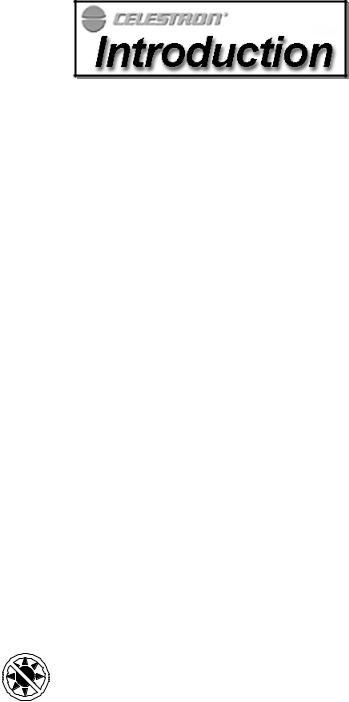
Congratulations on your purchase of the Celestron NexStar! The NexStar ushers in a whole new generation of computer automated technology. Simple and friendly to use, the NexStar is up and running after locating just two alignment stars. It’s the perfect combination of power and portability. If you are new to astronomy, you may wish to start off by using the NexStar's built-in Sky Tour feature, which commands the NexStar to find the most interesting objects in the sky and automatically slews to each one. Or if you are an experienced amateur, you will appreciate the comprehensive database of over 4,000 objects, including customized lists of all the best deep-sky objects, bright double stars and variable stars. No matter at what level you are starting out, the NexStar will unfold for you and your friends all the wonders of the Universe.
Some of the many standard features of the NexStar include:
•Incredible 4°/second slew speed.
•Fully enclosed motors and optical encoders for position location.
•Integrated hand controller – built into the side of the fork arm.
•Storage for programmable user defined objects; and
Many other high performance features!
The NexStar’s deluxe features combined with Celestron’s legendary optical standards give amateur astronomers one of the most sophisticated and easy to use telescopes available on the market today.
Take time to read through this manual before embarking on your journey through the Universe. It may take a few observing sessions to become familiar with your NexStar, so you should keep this manual handy until you have fully mastered your telescope’s operation. The NexStar hand control has built-in instructions to guide you through all the alignment procedures needed to have the telescope up and running in minutes. Use this manual in conjunction with the on-screen instructions provided by the hand control. The manual gives detailed information regarding each step as well as needed reference material and helpful hints guaranteed to make your observing experience as simple and pleasurable as possible.
Your NexStar telescope is designed to give you years of fun and rewarding observations. However, there are a few things to consider before using your telescope that will ensure your safety and protect your equipment.
Warning
Never look directly at the sun with the naked eye or with a telescope (unless you are using the proper solar filter). Permanent and irreversible eye damage may result.
Never use your telescope to project an image of the sun onto any surface. Internal heat build-up can damage the telescope and any accessories attached to it.
Never use an eyepiece solar filter or a Herschel wedge. Internal heat build-up inside the telescope can cause these devices to crack or break, allowing unfiltered sunlight to pass through to the eye.
Never leave the telescope unsupervised, either when children are present or adults who may not be familiar with the correct operating procedures of your telescope.
4
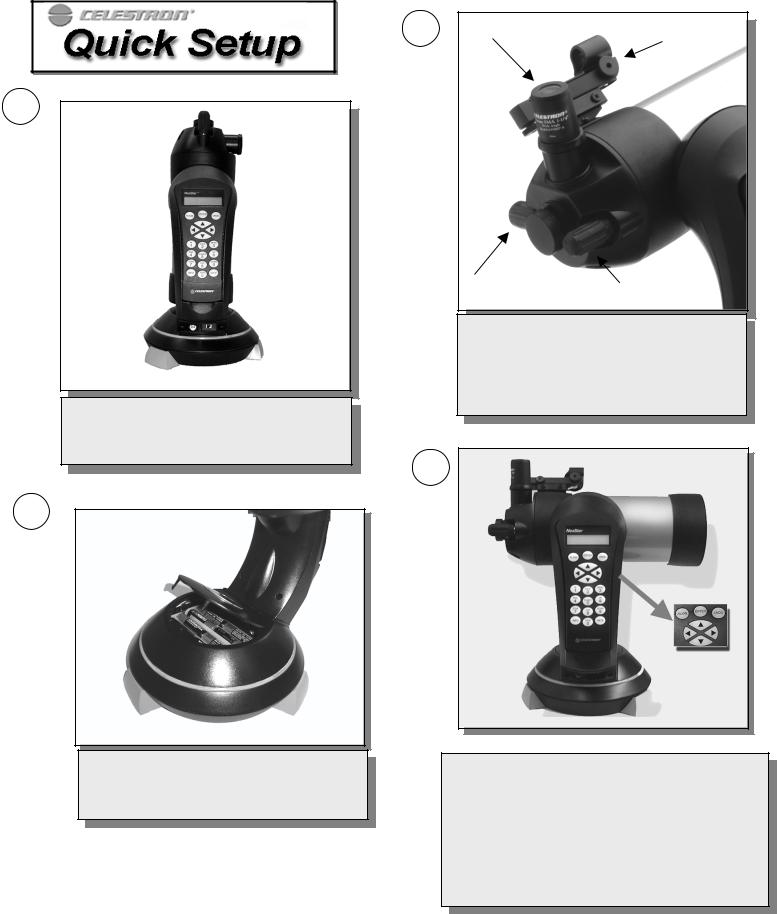
3
1
Remove the NexStar from its packaging and place the base on a sturdy, level surface. Remove the accessories from their individual boxes.
4
2
Rotate the tube so it is level with the ground. Lift the battery compartment cover to install batteries. Power the NexStar using the switch next to the 12v outlet at the base of the fork arm.
Eyepiece |
StarPointer |
Flip Mirror
Focuser Knob
Attach the included accessories (eyepiece and Star Pointer finderscope) and remove the front lens cover. Remove plastic cover over the battery and turn-on the Star Pointer by rotating the dial on the side. (For instructions on aligning the Star Pointer see the Assembly section of the manual).
The first time the NexStar is powered on the display will read Select Model. Use the Up and Down scroll buttons to select your NexStar model from the list and press ENTER. When the display reads NexStar Ready, press ENTER to AutoAlign the NexStar. The hand control display will ask you to move the telescope tube so that it is level with the ground and facing the north horizon. Use the direction arrow buttons on the hand control to position the telescope north and level. (See Astronomy Basics for help on finding north).
5
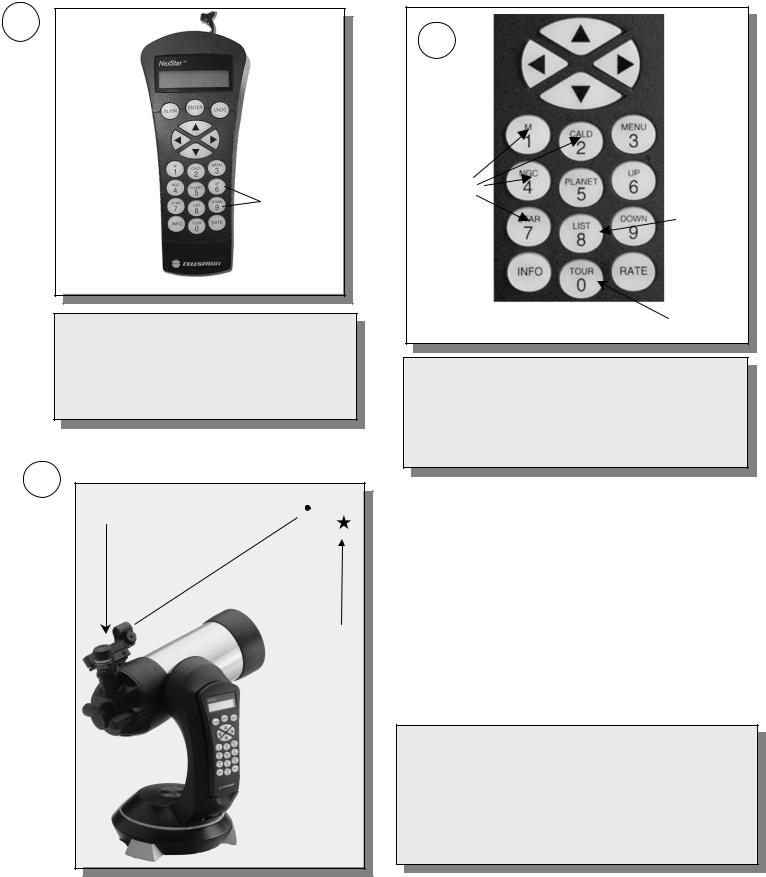
5
Direction
Buttons

Up and Down
Scroll Buttons
Input the necessary date and time information as instructed by the hand control. Press ENTER after each entry. The NexStar will also ask for time zone and location information. Use the UP and Down scroll buttons to select from the various options, pressing ENTER after each selection. (See Hand Control section for detailed alignment procedures).
6
Star Pointer Finderscope
Alignment Star
7
Catalog Keys 
Object List
Button
TOUR Button
Press the TOUR button on the hand control. The hand control will display a list of objects that are visible for the date and location entered. Press INFO to read information about the object displayed. Press the DOWN scroll key to display the next object. Press ENTER to slew to (go to) the displayed object.
The NexStar will automatically pick an alignment star and slew the telescope close to that star. Once there, the display will ask you to use the arrow buttons to aim the Star Pointer at the star. If the star is not visible (perhaps behind a tree), press UNDO to select a new star. Next, center the star in the eyepiece and press ALIGN. Repeat these steps for the second star alignment. When complete, display will read "Alignment Successful".
6
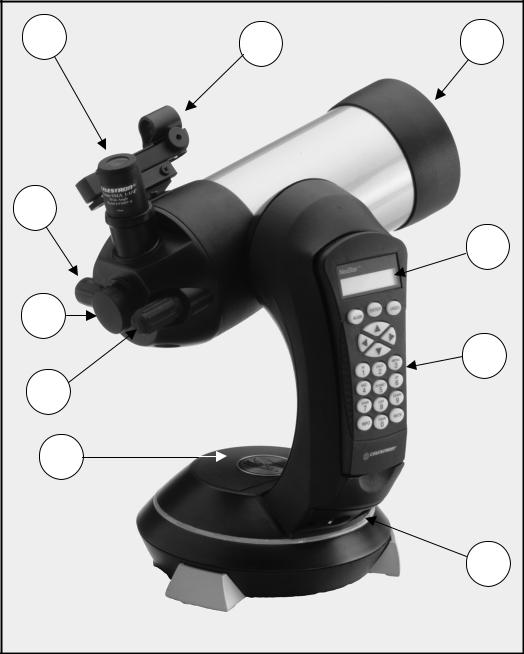
9 |
10 |
1 |
8
2
7
3
6
5
4
1 |
Optical Tube |
6 |
Focuser Knob |
2 |
Liquid Crystal Display |
7 |
Straight Through Photographic Adapter |
|
|
|
|
3 |
Hand Control |
8 |
Flip Mirror Control |
|
|
|
|
4 |
ON/OFF Switch |
9 |
Eyepiece |
|
|
|
|
5 |
Battery Compartment |
10 |
Star Pointer Finderscope |
|
|
|
|
7
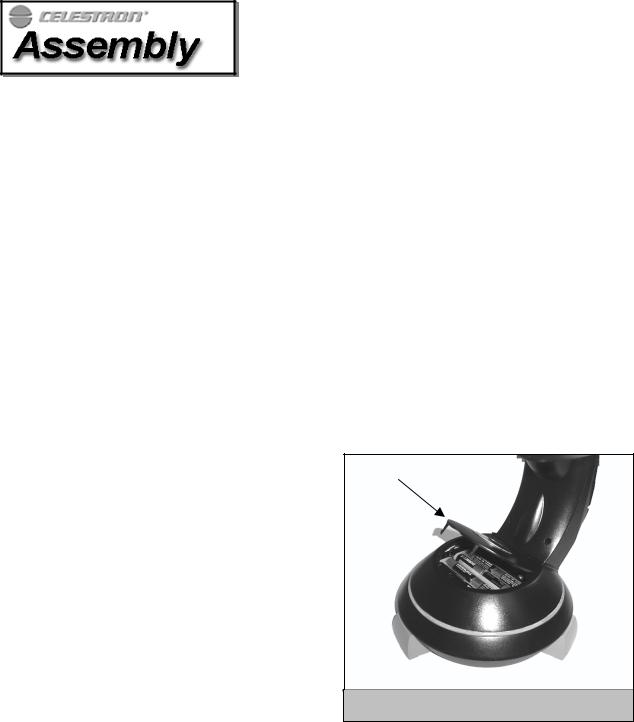
The NexStar 4 comes completely pre-assembled and can be operational in a matter of minutes. The NexStar is conveniently packaged in one reusable shipping carton that contains all of the following accessories:
•25mm SMA Eyepiece – 1¼"
•Star Pointer Finderscope
•Computerized Hand Control with 4,000 Object Database
Assembling the NexStar
Start by removing the telescope from its shipping carton and setting the round base on a flat table or surface. It is best to carry the telescope by holding it from the lower portion of the fork arm and from the bottom of the base. Remove all of the accessories from their individual boxes. Remember to save all of the containers so that they can be used to transport the telescope. Before the batteries can be installed, the telescope tube should be positioned horizontal to the ground. To do this, gently rotate the front of the tube upwards until it is level with the ground.
Powering the NexStar
The NexStar can be powered by eight AA batteries (not included), an optional 12v AC adapter or an optional car battery adapter. The battery compartment is located in the center of the telescope's base (see figure 3-1).
To power the NexStar with batteries:
1.Remove the battery cover from the center of the base by gently lifting up on the round portion of the cover.
2.Insert the batteries into the battery compartment of the base.
3.Reattach the battery compartment door by gently pushing down on the cover until it snaps into place.
4.Turn on the power to the NexStar by flipping the switch, located at the base of the fork arm, to the "On" position.
Battery Compartment
Cover
Figure 3-1: The NexStar 4 Battery Compartment
8
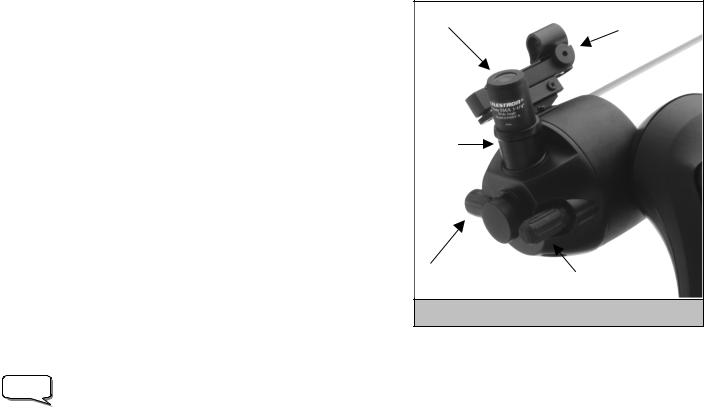
The Hand Control
The hand control is located on the side of the fork arm and can be removed and used remotely or used while attached to the fork. The hand control attaches to the fork arm by resting on two posts, located on the bottom of the hand control cradle, and a clip inside the fork arm. To remove the hand control from the fork arm cradle, gently lift the hand control upwards and pull out. To return the hand control into the fork arm, lower the hand control into the cradle so that the two holes in the bottom of the hand control go over the posts on the bottom of the cradle, and the opening in the back of the hand control slides over the clip inside the fork arm.
Once the telescope is powered up, the hand control can be used to move the optical tube in altitude (up and down) and azimuth (side to side). Use the Up arrow directional button to move the telescope tube until it is roughly parallel to the ground. This will make it more convenient to attach the necessary accessories as well as remove the front lens cover and install batteries when they are needed.
You are now ready to attach the included visual accessories onto the telescope optical tube.
The Eyepiece
The eyepiece, or ocular, is the optical element that magnifies the image focused by the telescope. The NexStar 4 has an internal diagonal mirror that diverts light to the eyepiece barrel on top of the telescope's rear cell. The eyepiece fits into the barrel built-in to the rear cell. To install the eyepiece:
1.Loosen the thumbscrew on the eyepiece barrel so it does not obstruct the inner diameter of the barrel.
2.Slide the chrome portion of the eyepiece into the eyepiece barrel.
3.Tighten the thumbscrew to hold the eyepiece in place.
To remove the eyepiece, loosen the thumbscrew on the star diagonal and slide the eyepiece out.
Eyepieces are commonly referred to by focal length and barrel diameter. The focal length of each eyepiece is printed on the eyepiece barrel. The longer the focal length (i.e., the larger the number) the lower the eyepiece power or magnification; and the shorter the focal length (i.e., the smaller the number) the higher the magnification. Generally, you will use low-to-moderate power when viewing. For more information on how to determine power, see the section on “Calculating Magnification.”
Eyepiece |
StarPointer |
Diagonal
Barrel
Flip Mirror Control
Focuser Knob
Figure 3-2 – The Rear Cell with Visual Accessories
Barrel diameter is the diameter of the barrel that slides into the telescope's eyepiece barrel. The NexStar uses eyepieces with a standard 1-1/4" barrel diameter.
Note:
As mentioned, the NexStar has an internal flip mirror that can divert light either through the eyepiece barrel at the top of the rear cell or directly through the photographic opening at the back of the rear cell. Make sure that the flip mirror is in the "up" position for viewing with an eyepiece and in the "down" position for taking photographs (see Astronomy Basics section of the manual).
9
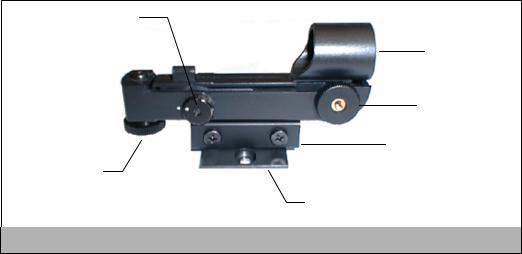
The Star Pointer Finderscope
The Star Pointer is the quickest and easiest way to point your telescope exactly at a desired object in the sky. It's like having a laser pointer that you can shine directly onto the night sky. The Star Pointer is a zero magnification pointing tool that uses a coated glass window to superimpose the image of a small red dot onto the night sky. While keeping both eyes open when looking through the Star Pointer, simply move your telescope until the red dot, seen through the Star Pointer, merges with the object as seen with your unaided eye. The red dot is produced by a light-emitting diode (LED); it is not a laser beam and will not damage the glass window or your eye. The Star Pointer comes equipped with a variable brightness control, two axes alignment control and a quick-release dovetail mounting bracket. Before the Star Pointer is ready to be used, it must be attached to the telescope tube and properly aligned:
ON/OFF
Variable Brightness
Control
Glass Window
Azimuth Control
Knob
Mounting Track
Altitude Control
Knob
Dovetail Mounting Bracket
Figure 3-3: The Star Pointer Finderscope with Mounting Bracket
Star Pointer Installation
1.Locate the dovetail mounting bracket on the rear cell of the optical tube.
2.Slide the mounting track at the bottom of the Star Pointer over the dovetail portion of the bracket. It may be necessary to loosen the two screws on the side of the mounting track before sliding it over the dovetail. The end of the Star Pointer with the glass window should be facing out towards the front of the telescope.
3.Tighten the two screws on the side of the mounting track to secure the Star Pointer to the dovetail bracket.
Star Pointer Operation
The star pointer is powered by a long life 3-volt lithium battery (#CR2032) located underneath the front portion of the Star Pointer. Like all finderscopes, the Star Pointer must be properly aligned with the main telescope before it can be used. This is a simple process using the azimuth and altitude control knobs located on the side and bottom of the Star Pointer. The alignment procedure is best done at night since the LED dot will be difficult to see during the day.
1.To turn on the Star Pointer, rotate the variable brightness control (see figure 3-3) clockwise until you here a "click". To increase the brightness level of the red dot, continue rotating the control knob about 180º until it stops.
Remember to remove the plastic cover over the battery, and always turn the power off after you have found an object. This will extend the life of both the battery and the LED.
2.Locate a bright star or planet and center it in a low power eyepiece in the main telescope.
3.With both eyes open, look through the glass window at the alignment star.
4.If the Star Pointer is perfectly aligned, you will see the red LED dot overlap the alignment star. If the Star Pointer is not aligned, take notice of where the red dot is relative to the bright star.
10
5.Without moving the main telescope, turn the Star Pointer's azimuth and altitude alignment controls until the red dot is directly over the alignment star.
If the LED dot is brighter than the alignment star, it may make it difficult to see the star. Turn the variable brightness control counterclockwise, until the red dot is the same brightness as the alignment star. This will make it easier to get an accurate alignment. The Star Pointer is now ready to be used.
11
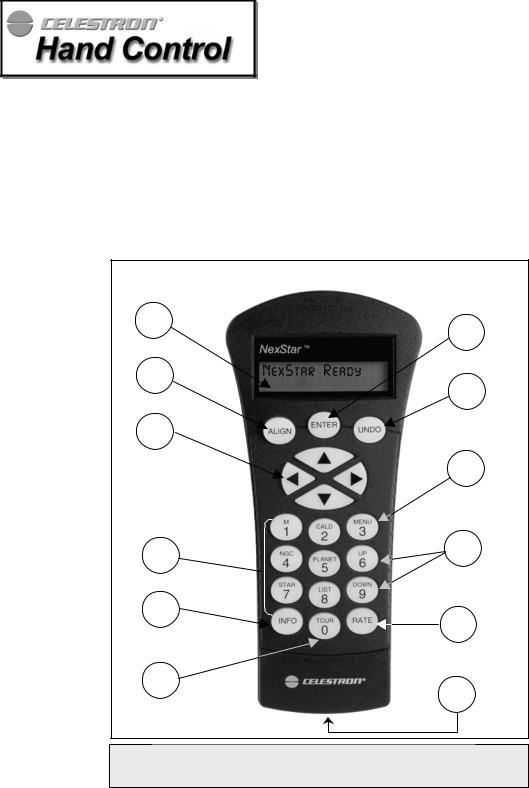
The NexStar 4 has a removable hand controller built into the side of the fork arm designed to give you instant access to all the functions the NexStar has to offer. With automatic slewing to over 4,000 objects, and common sense menu descriptions, even a beginner can master its variety of features in just a few observing sessions. Below is a brief description of the individual components of the NexStar 4 hand controller:
1.Liquid Crystal Display (LCD) Window: Has a dual-line, 16 character display screen that is backlit for comfortable viewing of telescope information and scrolling text.
2.Align: Instructs the NexStar to use a selected star or object as an alignment position.
3.Direction Keys: Allows complete control of the NexStar in any direction. Use the direction keys to center objects in the StarPointer finderscope and eyepiece.
1
7
2
8
3
9
10
4
5
11
6
12
Figure 4-1
The NexStar Hand Control
4.Catalog Keys: The NexStar has a key on the hand control to allow direct access to each of the catalogs in its 4,000+ object database. The NexStar contains the following catalogs in its database:
Messier – Complete list of all Messier objects.
NGC – Select list of all the deep-sky objects in the Revised New General Catalog.
12
Caldwell – A combination of the best NGC and IC objects. Planets - All 8 planets in our Solar System plus the Moon.
Stars – A compiled list of the brightest stars from the SAO catalog.
List – For quick access, all of the best and most popular objects in the NexStar database have been broken down into lists based on their type and/or common name:
Named Stars |
Common name listing of the brightest stars in the sky. |
Named Objects |
Alphabetical listing of over 50 of the most popular deep |
|
sky objects. |
Double Stars |
Numeric-alphabetical listing of the most visually stunning |
|
double, triple and quadruple stars in the sky. |
Variable Stars |
Select list of the brightest variable stars with the shortest |
|
period of changing magnitude. |
Asterisms |
A unique list of some of the most recognizable star |
|
patterns in the sky. |
5.Info: Displays coordinates and useful information about objects selected from the NexStar database.
6.Tour: Activates the tour mode, which seeks out all the best objects for a given month and automatically slews the NexStar to those objects.
7.Enter: Pressing Enter allows you to select any of the NexStar functions, accept entered parameters and slew the telescope to displayed objects.
8.Undo: Undo will take you out of the current menu and display the previous level of the menu path. Press Undo repeatedly to get back to a main menu or use it to erase data entered by mistake.
9.Menu: Displays the many setup and utilities functions such as tracking rate and user defined objects and many others.
10.Scroll Keys: Used to scroll up and down within any of the menu lists. A double arrow symbol on the right side of the LCD indicates that the scroll keys can be used to view additional information.
11.Rate: Instantly changes the rate of speed of the motors when the direction buttons are pressed.
12.RS-232 Jack: Allows you to interface with a computer and control the NexStar remotely.
Hand Control Operation
This section describes the basic hand control procedures needed to operate the NexStar. These procedures are grouped into three categories: Alignment, Setup and Utilities. The alignment section deals with the initial telescope alignment as well as finding objects in the sky; the setup section discusses changing parameters such as tracking mode and tracking rate; finally, the last section reviews all of the utility functions such as adjusting the telescopes slew limits and backlash compensation.
Alignment Procedure
In order for the NexStar to accurately point to objects in the sky, it must first be aligned with two known positions (stars) in the sky. With this information, the telescope can create a model of the sky, which it uses to locate any object with known coordinates.
Auto-Align
Auto-Align is the easiest way to get your NexStar aligned and ready to observe. Even if you do not know a single star in the sky, the NexStar will align itself by guiding the user through the alignment procedure by asking for basic information like the date, time and location. The NexStar will then automatically choose two stars for alignment and roughly center the stars in the field of view of the Star Pointer. Before the telescope is ready to be aligned, it should be set up in an outside location with all accessories (eyepiece and Star Pointer) attached and lens cover removed as described in the Assembly section of the manual.
1.Once the NexStar is powered on the display will read NexStar Ready. Press ENTER to begin alignment.
The first time that the NexStar is used, it will request information to help identify the model of telescope. Once powered on, the hand control will display the message Select Model. Use the Up and Down menu keys (10) to scroll through the different NexStar models. Press ENTER when your NexStar model is displayed on the hand control. This information will be retained for future use and will not be displayed again. If for some reason the incorrect model was selected or you wish
13

Helpful
Hints
to use your hand control on a different NexStar model, the Select Model utility feature allows you to re-select the proper NexStar model from the displayed list (see Select Model later in this section).
2.Use the Up and Down scroll keys to select AutoAlign if it is not already displayed, and press ENTER.
3.The telescope will then ask you to use the direction keys (3) to level the telescope tube and point the front of the telescope towards north. North can be found by finding the direction of the North Star (Polaris) or by using a compass. You do not need to point at the North Star, only the north horizon. Alignment only needs to be approximate, however a close alignment will make the auto alignment more accurate. Once the telescope is in the north and level position, press ENTER.
4.The hand control display will then ask for the following information:
Location - The NexStar will display a list of cities to choose from. Choose the city from the database that is closest to your current observing site. The city you choose will be remembered in the hand controls memory so that it will be automatically displayed the next time an alignment is done. Alternatively, if you know the exact longitude and latitude of your observing site, it can be entered directly into the hand control and remembered for future use as well. To choose a location city:
Use the Up and Down scroll keys to choose between City Database and Custom Site. City Database will allow you to select the closest city to your observing site from a list of either international or U.S. location. Custom Site allows you to enter the exact longitude and latitude of your observing site. Select City Database and press ENTER.
The hand control will allow you to choose from either U.S. or international locations. For a listing of U.S. locations by state and then by city, press ENTER while United States is displayed. For international locations, use the Up or Down scroll key to select Internationaland press ENTER.
To display a list of local cities, first select your state from the alphabetical listing (or a list of countries if International locations was selected) and press ENTER.
Choose the closest city to your location from the displayed list and press ENTER.
Time - Enter the current time for your area. You can enter either the local time (i.e. 8:00), or you can enter military time (i.e. 20:00).
Select PM or AM. If military time was entered, the hand control will bypass this step.
Choose between Standard time or Daylight Savings time. Use the Up and Down scroll buttons (10) to toggle between options.
Select the time zone that you are observing from. Again, use the Up and Down buttons (10) to scroll through the choices. For time zone information, refer to the Time Zone map in the appendix of this manual.
Date - Enter the month, day and year of your observing session. The display will read: mm/dd/yy.
•If the wrong information has been input into the hand control, the UNDO button will act as a backspace allowing the user to re-enter information.
•The next time that your NexStar is Auto Aligned, the hand control will automatically display the last location (either a city or longitude/latitude) that was entered. Pressing the UNDO button will allow you to go back and select a new city location or longitude/latitude.
Based on this information, the NexStar will automatically select a bright star that is above the horizon and slew towards it. At this point the telescope is only roughly aligned, so the alignment star should only be close to the field of view of the Star Pointer finder. Once finished slewing, the display will ask you to use the arrow buttons to align the selected star with the red dot in the center of the Star Pointer. If for some reason the chosen star is not visible (perhaps behind a tree or building) you can press UNDO to select and slew to a different star. Once centered in the finder, press ENTER. The display will then instruct you to center the star in the field of view of the eyepiece. When the star is centered, press ALIGN to accept this star as your first alignment star. (There is no need to adjust the slewing rate of the motors after each alignment step. The NexStar automatically selects the best slewing rate for aligning objects in both the Star Pointer and the eyepiece). After the first alignment star has been entered the NexStar will automatically slew to a second alignment star and have you repeat the same
14

Observing
Tips
procedure for that star. When the telescope has been aligned to both stars the display will read Alignment Successful, and you are now ready to find your first object.
If the wrong star was centered and aligned to, the NexStar display will read Align Failed. Press UNDO to begin the alignment procedure again.
 If you are not sure if the correct star was centered, always remember that the alignment star will be the brightest star nearest the field of view of the finder. There may be other fainter stars visible that are closer to the center of the Star Pointer, but the actual alignment star will be obviously brighter than any other star in the area.
If you are not sure if the correct star was centered, always remember that the alignment star will be the brightest star nearest the field of view of the finder. There may be other fainter stars visible that are closer to the center of the Star Pointer, but the actual alignment star will be obviously brighter than any other star in the area.
 For the best possible pointing accuracy, always center the alignment stars using the up arrow button and the right arrow button. Approaching the star from this direction when looking through the eyepiece will eliminate much of the backlash between the gears and assure the most accurate alignment possible.
For the best possible pointing accuracy, always center the alignment stars using the up arrow button and the right arrow button. Approaching the star from this direction when looking through the eyepiece will eliminate much of the backlash between the gears and assure the most accurate alignment possible.
Two Star Alignment
With the two-star alignment method, the NexStar requires the user to know the positions of only two bright stars in order to accurately align the telescope with the sky and begin finding objects. Here is an overview of the two-star alignment procedure:
1.Once the NexStar is powered on, use the Up and Down scroll keys to select Two-Star Align, and press ENTER.
2.The NexStar display will ask you to move the telescope tube until it is horizontal to the ground. To do this, use the direction keys (3) to move the telescope until it is roughly level with the ground. Press ENTER.
3.The SELECT STAR 1 message will appear in the top row of the display. Use the Up and Down scroll keys (10) to select the star you wish to use for the first alignment star. Press ENTER.
4.NexStar then asks you to center in the eyepiece the alignment star you selected. Use the direction buttons to slew the telescope to the alignment star and carefully center the star in the eyepiece.
5.Once the alignment star is centered in the field of view of the eyepiece, press the ALIGN key (2) to accept this position.
6.NexStar will then ask you to select and center a second alignment star and press the ALIGN key. It is best to choose alignment stars that are a good distance away from one another. Stars that are at least 40º to 60º apart from each other will give you a more accurate alignment than stars that are close to each other.
Once the second star alignment is completed properly, the display will read Alignment Successful, and you will hear the tracking motors turn-on and begin to track.
Quick-Align
Quick-Align allows you to input all the same information as you would for the AutoAlign procedure. However, instead of slewing to two alignment stars for centering and alignment, the NexStar bypasses this step and simply models the sky based on the information given. This will allow you to roughly slew to the coordinates of bright objects like the moon and planets and gives the NexStar the information needed to track objects in altazimuth in any part of the sky. Quick-Align is not meant to be used to accurately locate small or faint deep-sky objects or to track objects accurately for photography. Note: Once a Quick-Align has been done, you can use the Re-alignment feature (see below) to improve your telescopes pointing and tracking accuracy.
To use Quick-Align:
1.Select Quick-Align from the alignment options.
2.Use the arrow buttons to level the tube and position the telescope tube towards north and press ENTER.
3.The hand control will then ask you to input all the same time and location information as you would for the AutoAlign procedure.
Once entered, the NexStar will model the sky based on this information and display Alignment Successful.
15
